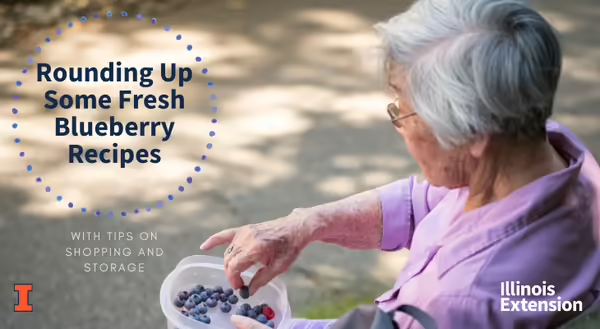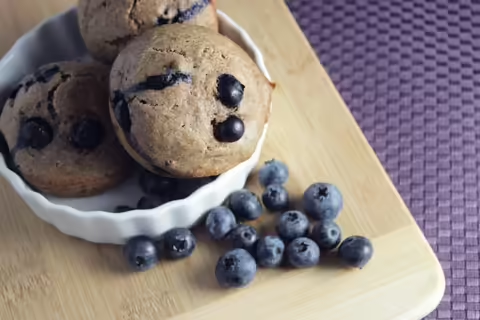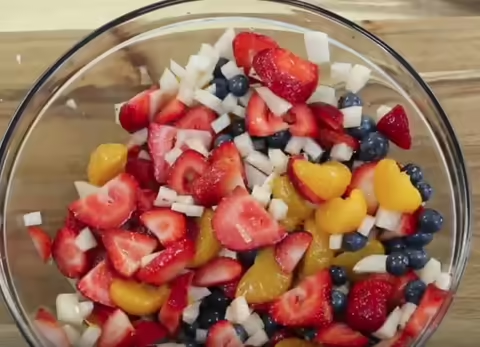
I got to spend some time a few weeks ago picking blueberries! Put on my hat and UV shirt, brought a bottle of water, and got to pickin'. Thanks goodness for taller blueberry bushes so I could take a break from crouching down. Now the question is: what to do with all the fresh blueberries?
Nutritionally, a 1/2-cup of blueberries contains around 40 calories, 10g carbohydrates, 2g fiber, and is a good source of vitamin C, folate, and vitamin K. Blueberries do not have significant amounts of fat, sodium, or protein.
- Buy: Blueberries should be a deep blue-purple color, firm, and plump. Avoid berries that are mashed, shriveled, or have wrinkled flesh or mold. If choosing processed blueberries, such as juiced or frozen, look for those without added sugar. While you can find fresh blueberries almost year-round in stores, the best quality and lowest prices will be in summer months.
- Shop Local: I have two local u-pick blueberry patches near me and I'm guessing you might too. An internet search, a local newspaper, or even social media might reveal some local spots.
- Price: According to the U.S. Department of Agriculture, fresh blueberries cost around $4.40 per pound, with frozen berries around $3.50 per pound. These are certainly one of the more expensive fruits, so look for good quality berries before you buy.
- Store: Keep unwashed berries in your refrigerator for up to a week, discarding soft or wrinkled berries. Like other fresh fruits, washing berries before storage leads them to spoil quickly. Or freeze them yourself for longer storage with instructions from the National Center for Home Food Preservation. Try out their Spiced Blueberry-Peach Jam to make use of peaches coming into season too!
- Prepare: Wash before eating or using in recipes. Remove small stems, if any are present.
- Eat: Commonly eaten as a fruit side to meals or as a snack, blueberries work well in sweet dishes such as bakery items and fruit salads. Blueberries make excellent additions to savory recipes, like lettuce salads and sauces for meat.
Blueberry Bean Muffins | Print recipe
(Makes 12 muffins)
1 can (15 ounces) red kidney beans
1/3 cup nonfat milk
1/2 cup sugar
1/4 cup butter
3 eggs
2 tsp vanilla
1 cup all-purpose flour
1/2 cup whole wheat flour
1 tsp baking soda
1 1/4 tsp cinnamon
1/2 tsp salt
3/4 tsp ground cloves
pinch ground nutmeg
1 cup blueberries, fresh or frozen
- Preheat oven to 375°F.
- Wash hands with soap and water.
- Process beans and milk in food processor or blender until smooth.
- Mix sugar and butter in large bowl. Beat in eggs and vanilla. Mix in bean mixture until well blended.
- Stir together dry ingredients (flours, baking soda, and spices) in a separate bowl. Add to bean and egg mixture. If fresh, gently rub blueberries under cool running water. Gently stir in blueberries.
- Spoon mixture into 12 greased or paper-lined muffin cups. Bake muffins in oven until toothpick inserted in centers come out clean, about 20 to 25 minutes.
- Cool in pans on wire racks 5 minutes until removing.
Note: Any canned bean variety can be easily substituted.
Nutritional analysis per serving: 180 calories, 6g fat, 300mg sodium, 27g carbohydrate, 3g fiber, 6g protein
Source: Eat.Move.Save., Illinois Nutrition Education Programs, University of Illinois Extension.
Jicama Summer Salad | Print recipe | Watch video
(Serves 6)
If you have never used jicama, peel it like a potato and dice. It is sweet and crunchy raw, like an apple.
Half of 1 jicama, peeled and diced
3 cups strawberries, sliced
6 oz. container blueberries
1 can (15 oz.) mandarin oranges, drained
1 Tbsp lime juice
2 1/2 Tbsp honey
1/2 tsp cinnamon
- Wash hands.
- Wash produce. Cut jicama and strawberries into sizes listed.
- In a large bowl, combine jicama, strawberries, blueberries, and mandarin oranges
- Mix together lime juice, honey, and cinnamon in a small bowl until well mixed. Drizzle over jicama mixture. Serve immediately or store in the refrigerator 3-4 days.
Nutritional analysis per serving: 120 calories, 0g fat, 10mg sodium, 31g carbohydrate, 4g fiber, 1g protein
Source: Lisa Peterson, University of Illinois Extension, Nutrition & Wellness Educator, 2015
Lemon Blueberry Cheesecake | Print recipe | Watch video
(Serves 12)
Our oven needed 45 minutes to fully bake the filling, so keep cooking until the center is firm.
Crust
1 ½ cups graham cracker crumbs
3 Tbsp nonfat plain yogurt
- Preheat oven to 350°F. In a medium bowl, mix together graham cracker crumbs and yogurt. Press into a greased 8x8-inch pan or 9-inch round pan. Bake for 5 minutes and let cool.
Filling
1 (8 oz.) package Neufchatel cheese
3/4 cup nonfat plain yogurt
1/3 cup granulated sugar
2 Tbsp fresh lemon juice
Zest of one small lemon
2 egg whites
1 tsp vanilla extract
2 Tbsp all-purpose flour
1 cup fresh blueberries
- Wash hands.
- In a large bowl, beat Neufchatel cheese, yogurt and sugar with an electric hand mixer. Add the lemon juice, zest, egg whites, vanilla, and flour and beat until fully combined. Fold in blueberries.
- Pour filling over the crust and return to oven. Bake at 350°F for 25-30 minutes. Remove from oven, allow to cool and refrigerate for at least 3 hours before serving.
Nutrition analysis per serving: 280 calories, 9g fat, 300mg sodium, 45g carbohydrate, 2g fiber, 6g protein
Source: Jenna Smith, University of Illinois Extension, Nutrition & Wellness Educator, 2016
References:
- US Department of Agriculture, Agriculture Research Service, National Nutrient Database for Standard Reference
Post originally published in 2014; content updated in 2021.
Healthy Eats and Repeat
How much difference is there between canned and frozen foods? How should you cook venison? When is the best time to buy avocados? Get answers to these questions as well as other tips, tutorials and recipes for common kitchen foods and items with University of Illinois Extension Nutrition & Wellness Educator Caitlin Mellendorf’s blog Healthy Eats and Repeat. Build your best life. Trust Extension to help.
Caitlin Mellendorf is an Illinois Extension Nutrition and Wellness Educator serving DeWitt, Macon and Piatt Counties in Central Illinois. She is a Registered Dietitian and her work focuses on helping community members gain the knowledge, skills and tools to live healthier, more nutritious lifestyles. This includes providing programs and answering questions about heart health, diabetes, food safety, food preservation, grocery shopping and cooking. You can reach Caitlin by email at chuth2@illinois.edu or call 217.877.6042. Check out her nutrition blog Healthy Eats and Repeats for seasonal recipes and of an exploration of common kitchen foods.


